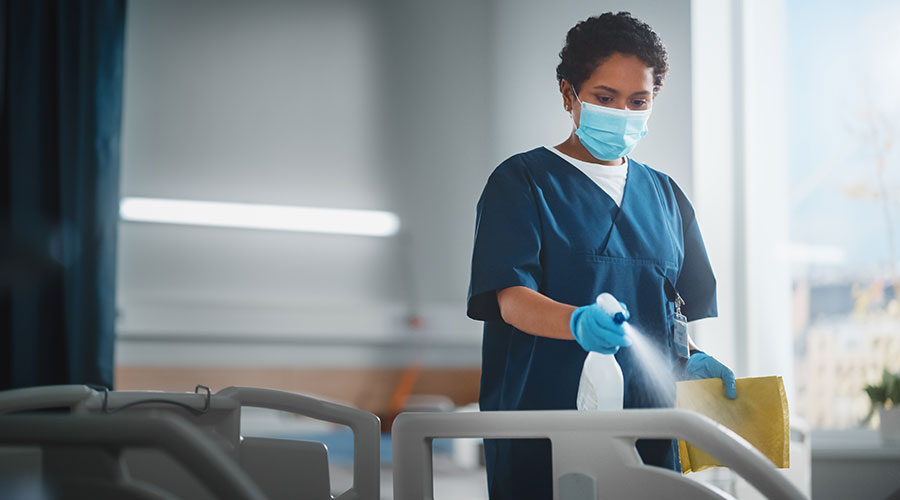Antimicrobial-resistant (AMR) bacteria are a global health crisis, and prevention saves lives. The rising threat of AMR demands immediate, unwavering action. We must adopt a "whatever it takes" stance rather than questioning the costs.
While environmental services (EVS) departments cannot fully eradicate AMR bacteria, timely interventions can mitigate their impact. Bacteria replicate rapidly, with some species doubling their population every 20 minutes. Effective measures must outpace this rapid bacterial growth.
The most common and life-threatening multiple-drug-resistant pathogens have been grouped together under the acronym ESKAPE which stands for:
- Enterococcus faecium
- Staphylococcus aureus
- Klebsiella pneumoniae
- Acinetobacter baumannii
- Pseudomonas aeruginosa
- Enterobacter spp.
To break the chain of contaminated hospital surfaces, selecting the most effective product is essential in healthcare settings. It is important that environmental services workers get the dilution of disinfectants right according to the manufacturer’s recommendation, or they risk affecting the efficacy of the disinfectant.
With this growing concern over the ESKAPE pathogens, it is vital to use efficient, hospital-grade disinfectants that are effective against high-risk microorganisms while still being user friendly and non-hazardous. Among the key factors to consider when choosing a disinfectant are these:
- Meet the testing standards for the healthcare sector.
- Effective according to the kill claims.
- Compatible with surfaces and other materials.
- Dilution and ease of use.
- Dwell time & pH neutral.
- Kills dry-surface biofilm.
- Safety of staff and patients.
If EVS workers cannot treat infections, they should at least try to prevent pathogens from reaching patients in the first place. Removing dirt from surfaces, whether visible or not, is fundamental to good health, and so is educating those whose job it is to clean the patient care environment.
Related: Needed: New Framework for Environmental Services Workers
The stakes are too high to allow resident or patient rooms to be cleaned by a person who is not educated about disease transmission. EVS workers are essential members of the patient care team and must be properly compensated, regarded as a part of the facility’s multi-modal infection prevention program, be well trained in the nuances of cleaning and disinfection, be allotted the time to do the necessary tasks, be equipped with the best-in-class tools to clean and disinfect surfaces and be educated about disease prevention and transmission.
When hospitals want to compete in their markets, leaders often look to the latest 128-slice, 3D CT scanner, a Da Vinci robot to perform surgeries, recruit the best surgeon, or begin a new service line with the best return on investment. While these capital expenditures and improvements might attract publicity for a moment, boards of directors need to consider a different, low-cost option that provides the best chance to improve patient satisfaction, reduce healthcare-associated infections and improve the bottom line: the EVS department.
Whatever the cost, an educated EVS worker will be viewed as a knowledgeable professional working among other healthcare professionals who also are certified or registered in their fields. Knowledge leads EVS workers to be proud of the profession they have chosen and respected by those they work alongside of.
It is time for EVS departments, still the Cinderellas of infection prevention and control, to step into the spotlight and do whatever it takes to address the rising threat of AMR bacteria.
J. Darrel Hicks, BA, MESRE, CHESP, Certificate of Mastery in Infection Prevention, is the past president of the Healthcare Surfaces Institute. Hicks is nationally recognized as a subject matter expert in infection prevention and control as it relates to cleaning. He is the owner and principal of Safe, Clean and Disinfected. His enterprise specializes in B2B consulting, webinar presentations, seminars and facility consulting services related to cleaning and disinfection. He can be reached at darrel@darrelhicks.com, or learn more at www.darrelhicks.com.

 Grounding Healthcare Spaces in Hospitality Principles
Grounding Healthcare Spaces in Hospitality Principles UC Davis Health Selects Rudolph and Sletten for Central Utility Plant Expansion
UC Davis Health Selects Rudolph and Sletten for Central Utility Plant Expansion Cape Cod Healthcare Opens Upper 2 Floors of Edwin Barbey Patient Care Pavilion
Cape Cod Healthcare Opens Upper 2 Floors of Edwin Barbey Patient Care Pavilion Building Sustainable Healthcare for an Aging Population
Building Sustainable Healthcare for an Aging Population Froedtert ThedaCare Announces Opening of ThedaCare Medical Center-Oshkosh
Froedtert ThedaCare Announces Opening of ThedaCare Medical Center-Oshkosh